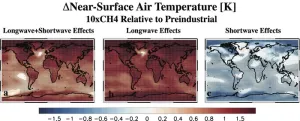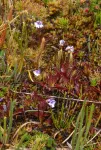(Press-News.org) Most climate models do not yet account for a new UC Riverside discovery: methane traps a great deal of heat in Earth’s atmosphere, but also creates cooling clouds that offset 30% of the heat.
Greenhouse gases like methane create a kind of blanket in the atmosphere, trapping heat from Earth’s surface, called longwave energy, and preventing it from radiating out into space. This makes the planet hotter.
“A blanket doesn’t create heat, unless it’s electric. You feel warm because the blanket inhibits your body’s ability to send its heat into the air. This is the same concept,” explained Robert Allen, UCR assistant professor of Earth sciences.
In addition to absorbing longwave energy, it turns out methane also absorbs incoming energy from the sun, known as shortwave energy. “This should warm the planet,” said Allen, who led the research project. “But counterintuitively, the shortwave absorption encourages changes in clouds that have a slight cooling effect.”
This effect is detailed in the journal Nature Geoscience, alongside a second finding that the research team did not fully expect. Though methane generally increases the amount of precipitation, accounting for the absorption of shortwave energy suppresses that increase by 60%.
Both types of energy — longwave (from Earth) and shortwave (from sun) — escape from the atmosphere more than they are absorbed into it. The atmosphere needs compensation for the escaped energy, which it gets from heat created as water vapor condenses into rain, snow, sleet, or hail.
“Essentially, precipitation acts as a heat source, making sure the atmosphere maintains a balance of energy,” said study co-author Ryan Kramer, a researcher at NASA Goddard Space Flight Center and the University of Maryland, Baltimore County.
Methane changes this equation. By holding on to energy from the sun, methane is introducing heat the atmosphere no longer needs to get from precipitation.
Additionally, methane shortwave absorption decreases the amount of solar radiation reaching Earth’s surface. This in turn reduces the amount of water that evaporates. Generally, precipitation and evaporation are equal, so a decrease in evaporation leads to a decrease in precipitation.
“This has implications for understanding in more detail how methane and perhaps other greenhouses gases can impact the climate system,” Allen said. “Shortwave absorption softens the overall warming and rain-increasing effects but does not eradicate them at all.”
The research team discovered these findings by creating detailed computer models simulating both longwave and shortwave methane effects. Going forward, they would like to conduct additional experiments to learn how different concentrations of methane would impact the climate.
Scientific interest in methane has increased in recent years as levels of emissions have increased. Much comes from industrial sources, as well as from agricultural activities and landfill. Methane emissions are also likely to increase as frozen ground underlying the Arctic begins to thaw.
“It’s become a major concern,” said Xueying Zhao, UCR Earth and planetary sciences Ph.D. student and study co-author. “We need to better understand the effects all this methane will bring us by incorporating all known effects into our climate models.”
Kramer echoes the need for further study. “We’re good at measuring the concentration of greenhouse gases like methane in the atmosphere. Now the goal is to say with as much confidence as possible what those numbers mean to us. Work like this gets us toward that goal,” he said.
END
Surprise effect: Methane cools even as it heats
Impacts of potent greenhouse gas: a bit lower than previously thought
2023-03-27
ELSE PRESS RELEASES FROM THIS DATE:
A puff of air could deliver your next vaccine (video)
2023-03-27
INDIANAPOLIS, March 27, 2023 — Nobody likes needles, but they’re necessary for delivering many vaccines and biologics into the body. But what if those could be puffed through the skin instead, with just a little pressure, like being hit in the arm with a foam toy? Today, scientists report steps toward making that a reality. Using powdered vaccines that don’t require refrigeration and a system driven by compressed gas, their “MOF-Jet” could easily deliver therapeutics against cancer and other diseases in a relatively painless way.
The researchers will present their results at the spring meeting of the American Chemical Society (ACS). ACS ...
Human cells help researchers understand squid camouflage
2023-03-27
INDIANAPOLIS, March 27, 2023 — Squids and octopuses are masters of camouflage, blending into their environment to evade predators or surprise prey. Some aspects of how these cephalopods become reversibly transparent are still “unclear,” largely because researchers can’t culture cephalopod skin cells in the lab. Today, however, researchers report that they have replicated the tunable transparency of some squid skin cells in mammalian cells, which can be cultured. The work could not only shed light on basic squid biology, but ...
Genetic tests unexpectedly find genes linked to heart disease — now what?
2023-03-27
Statement Highlights:
As health care professionals, researchers and consumers increasingly use genetic testing, they are uncovering incidental genetic abnormalities, or variants, that are associated with cardiovascular diseases.
The statement writing committee cautions that incidentally identified single gene variants may or may not be risk factors for disease, so it is important to interpret them correctly and cautiously.
The new scientific statement offers a framework to support health care professionals in appropriately assessing individual genetic variants, communicating findings with patients and families, and, when ...
Biochar and energy from pyrolysis can pave the way for carbon-neutral agriculture in China
2023-03-27
Since the Paris Agreement to combat global warming was reached in 2015, many countries have committed to becoming climate neutral, i.e., achieving net-zero greenhouse gas emissions. The world's largest agricultural country, China, is also committed to join the green transition. As the largest agricultural country, China is also the world's biggest emitter of greenhouse gases, yet it has set itself a target of achieving carbon neutrality by 2060.
According to Professor and Head of Land-CRAFT at Department of Agroecology at Aarhus University Klaus Butterbach-Bahl, this places huge demands on agricultural systems: "Agriculture in China accounts ...
Two striking new species of carnivorous plants discovered in the Andes of Ecuador
2023-03-27
A team of botanists from Ecuador, Germany, and the United States has described two new species of carnivorous plants with striking appearance. They are part of the butterworts (genus Pinguicula), a group of flowering plants with about 115 species that can catch and digest small insects with their sticky leaves. Whereas the majority of butterwort species is distributed in the northern hemisphere, these new species were discovered in the high Andes of southern Ecuador, close to the border with Peru.
Carnivorous plants use animals (usually small insects) as an additional source of nutrients ...
Global population could peak below 9 billion in 2050s
2023-03-27
The new projection is significantly lower than several prominent population estimates, including those of the United Nations. The researchers go further to say that if the world takes a “Giant Leap” in investment in economic development, education and health then global population could peak at 8.5 billion people by the middle of the century.
The new projections by researchers from the Earth4All initiative for the Global Challenges Foundation is published as a working paper People and Planet, 21st Century Sustainable Population Scenarios and Possible Living Standards Within Planetary Boundaries.
The team used a new system ...
Looking from different perspectives! Proper electronic structure of near-infrared absorbing functional dyes discovered
2023-03-27
Near-infrared light, whose wavelength is longer than visible light, is invisible and can pass through many substances. Organic materials that efficiently absorb near-infrared light are essential for technological innovations that utilize near-infrared light, such as the dyes in the infrared blocking filters of smartphone cameras and security inks. These and many more technical applications make developing new dyes that can absorb longer wavelengths of near-infrared light desirable.
Previously, near-infrared absorbing organic materials were treated as closed-shell molecules without unpaired electrons. However, a joint research group led by Associate Professor Takeshi Maeda, Assistant Professor ...
Bodies of people with mental illness are biologically older than their actual age
2023-03-27
New research shows that people with a lifetime history of mental disorders such as depression, bipolar disorder, or anxiety disorders have blood markers suggesting that they are older than their actual age. This may go some way to explaining why people with mental health problems tend to have shorter lifespans and more age-related diseases than the general population.
Dr Julian Mutz and Prof Cathryn Lewis, from King’s College London, looked at data on 168 different blood metabolites from 110,780 participants in the UK Biobank2. They linked these data to information on whether individuals had a history of mental illness and found that those with a mental illness ...
Study identifies two promising molecular targets for drug development in recurrent and metastatic cervical cancer
2023-03-27
NRG Oncology GOG-0240 is the phase 3 randomized trial which demonstrated that the incorporation of bevacizumab with chemotherapy resulted in a statistically significant and clinically meaningful survival benefit for women with recurrent and metastatic cervical carcinoma (NCT00803062). GOG-0240 was a proof of concept in anti-angiogenesis therapy and a proof of principle in supportive care and led directly to an indication for bevacizumab in this disease in over 60 countries. Whole genome sequencing and whole exome sequencing of tumor samples obtained in GOG-0240 suggest that ARID1A and PIK3CA could represent potential targets ...
'Nano inks' could passively control temperature in buildings, cars
2023-03-27
World-first ‘phase change inks’ that could transform how we heat and cool buildings, homes and cars – to achieve sophisticated ‘passive climate’ control – have been developed, with enormous potential to help reduce energy use and global greenhouse gas emissions.
New research published in The Royal Society of Chemistry’s Journal of Materials Chemistry A led by Dr Mohammad Taha, documents proof-of-concept ‘phase change inks’ that use nanotechnology to control temperature in everyday environments. They achieve this by adjusting the amount of radiation that can pass through ...
LAST 30 PRESS RELEASES:
Estimating unemployment rates with social media data
Climate policies can backfire by eroding “green” values, study finds
Too much screen time too soon? A*STAR study links infant screen exposure to brain changes and teen anxiety
Global psychiatry mourns Professor Dan Stein, visionary who transformed mental health science across Africa and beyond
KIST develops eco-friendly palladium recovery technology to safeguard resource security
Statins significantly reduce mortality risk for adults with diabetes, regardless of cardiovascular risk
Brain immune cells may drive more damage in females than males with Alzheimer’s
Evidence-based recommendations empower clinicians to manage epilepsy in pregnancy
Fungus turns bark beetles’ defenses against them
There are new antivirals being tested for herpesviruses. Scientists now know how they work
CDI scientist, colleagues author review of global burden of fungus Candida auris
How does stroke influence speech comprehension?
B cells transiently unlock their plasticity, risking lymphoma development
Advanced AI dodel predicts spoken language outcomes in deaf children after cochlear implants
Multimodal imaging-based cerebral blood flow prediction model development in simulated microgravity
Accelerated streaming subgraph matching framework is faster, more robust, and scalable
Gestational diabetes rose every year in the US since 2016
OHSU researchers find breast cancer drug boosts leukemia treatment
Fear and medical misinformation regarding risk of progression or recurrence among patients with breast cancer
Glucagonlike peptide-1 receptor agonists and asthma risk in adolescents with obesity
Reviving dormant immunity: Millimeter waves reprogram the immunosuppressive microenvironment to potentiate immunotherapy without obvious side effects
Safety decision-making for autonomous vehicles integrating passenger physiological states by fNIRS
Fires could emit more air pollution than previously estimated
A new way to map how cells choose their fate
Numbers in our sights affect how we perceive space
SIMJ announces global collaborative book project in commemoration of its 75th anniversary
Air pollution exposure and birth weight
Obstructive sleep apnea risk and mental health conditions among older adults
How talking slows eye movements behind the wheel
The Ceramic Society of Japan’s Oxoate Ceramics Research Association launches new international book project
[Press-News.org] Surprise effect: Methane cools even as it heatsImpacts of potent greenhouse gas: a bit lower than previously thought








